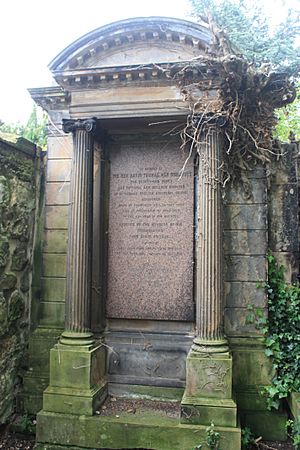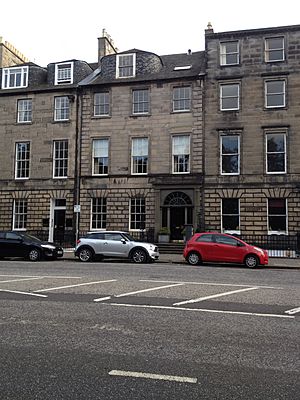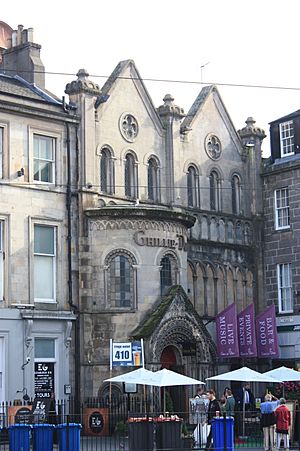David Drummond (minister) facts for kids
David Thomas Kerr Drummond (1805–1877) was an important Scottish minister. He was an Evangelical Christian. He used to be a member of the Scottish Episcopal Church. However, in 1842, he left to start his own church in Edinburgh. This event is known in Scottish religious history as "The Drummondite Schism." He was also one of the first amateur photographers.
Contents
Life of David Drummond
David Drummond was born in Edinburgh on August 25, 1805. His father, James Drummond, lived at 51 Queen Street. This was a new and popular area in Edinburgh's New Town.
Early Life and Education
David went to the High School in Edinburgh. He then studied to become a minister at the University of Edinburgh. He also studied at Worcester College, Oxford, and finished his studies in 1830.
Becoming a Minister
In 1830, he became a deacon in the Church of England. He worked as a curate (a type of assistant minister) in Compton Greenfield, Gloucestershire, from 1830 to 1832. He became a full priest in January 1832.
Return to Edinburgh and Church Work
In 1832, David Drummond returned to Edinburgh. He took over Old St Paul's church in the Old Town. In 1837, he moved to the new Holy Trinity Church. This church was on the west side of Dean Bridge. It served the growing number of people in Edinburgh who belonged to the Episcopal Church.
The "Drummondite Schism"
Around 1840, David Drummond was very interested in a religious movement called the Oxford Movement. In October 1842, his strong religious views led to disagreements. He wrote open letters to Bishop Charles Terrot. These disagreements caused a big split. Drummond decided to leave the Scottish Episcopal Church.
He was then encouraged to start a new church. This new church would follow the rules of the Church of England. It would also keep most of the old Episcopal traditions. But it would allow more freedom for prayer outside the church. This new church became known as the English Church in Edinburgh. This split was similar to, but separate from, another famous split in the Church of Scotland in 1843. Many other Scottish Episcopal Churches later followed Drummond's example.
St Thomas's Church
Drummond's new church was called St Thomas's English Episcopal Chapel. It was located on Rutland Place/Rutland Street, near the west end of Princes Street. This location was very close to another established Episcopal church, the Church of St John the Evangelist, Edinburgh.
Building for St Thomas's church began in 1842. This suggests that Drummond had already decided to leave the church before his public disagreements with Bishop Terrot. The first public meeting to set up this new church was announced in a newspaper on October 27, 1842.
Later Church Developments
Around 1852, Drummond brought in an English minister named Richard Hibbs to help him. However, this did not work out well. In 1854, Hibbs started another separate Episcopal Church. This new church, Christ's English Episcopal Chapel, was finished in 1857. After Hibbs left, Valentine Faithfull took his place.
Photography Hobby
David Drummond was also very interested in photography. He was one of the first amateur photographers. He joined the Edinburgh Photographic Society in 1861. He was also a member of the Photographic Society of Scotland. In 1862, he showed them a new portable photography tent he had made. He was even the vice president of the Photographic Society of Scotland from 1864 to 1867.
In 1868, he became a fellow of the Royal Society of Edinburgh. This is a special group for important scientists and thinkers. A photograph he took of Loch Earn in 1864 is now kept at the Scottish National Portrait Gallery. This photo was one of 16 pictures he showed in 1864. They were from a trip he took to Killin, St Fillans, and Loch Earn earlier that year.
Later Life and Death
In his later years, David Drummond lived in a flat at 6 Montpelier in the Bruntsfield area of Edinburgh. He retired in 1875 when he was 70 years old. He passed away on June 9, 1877, while visiting Pitlochry, Perthshire. His body was brought back to Edinburgh to be buried. His grave is in Duddingston Churchyard, on the south wall.

Artistic Recognition
An early photograph of David Drummond was taken around 1843 by Hill & Adamson. This picture is now kept at the Department of Special Collections in Glasgow University.




